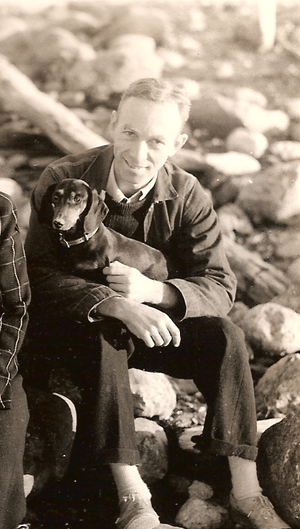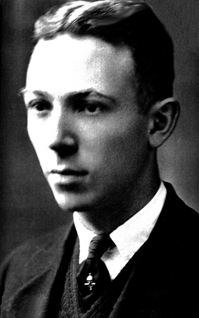E. B. White facts for kids
Quick facts for kids
E. B. White
|
|
|---|---|

White on the beach with his dachshund Minnie
|
|
| Born |
Elwyn Brooks White
July 11, 1899 Mount Vernon, New York, U.S.
|
| Died | October 1, 1985 (aged 86) Brooklin, Maine, U.S.
|
| Resting place | Brooklin Cemetery, Brooklin, Maine, U.S. |
| Alma mater | Cornell University |
| Occupation | Writer |
| Spouse(s) |
Katharine Sergeant
(m. 1929; died 1977) |
| Signature | |
 |
|
Elwyn Brooks White (born July 11, 1899 – died October 1, 1985) was a famous American writer. He wrote many popular books for children. Some of his most loved stories include Stuart Little (1945), Charlotte's Web (1952), and The Trumpet of the Swan (1970).
In 2012, a survey of School Library Journal readers voted Charlotte's Web as the best children's novel ever! White also wrote for The New Yorker magazine. He helped write an important English language style guide called The Elements of Style.
Contents
The Early Life of E.B. White
E.B. White was born in Mount Vernon, New York. He was the youngest of six children. His father, Samuel Tilly White, ran a piano company. His mother, Jessie Hart White, was the daughter of a Scottish-American painter named William Hart.
Elwyn's older brother, Stanley Hart White, was a professor. He invented the vertical garden. Stan taught E.B. White to read and to love nature.
College Days at Cornell
White went to Cornell University. While there, he was part of the Student Army Training Corps (SATC) during World War I. This program helped train soldiers while they continued their college studies.
White graduated from Cornell in 1921. He earned a Bachelor of Arts degree. At Cornell, he got the nickname "Andy." This was a tradition for any male student with the last name White. It was a nod to Cornell's co-founder, Andrew Dickson White.
During college, he worked as an editor for The Cornell Daily Sun. He was also a member of several student groups.
Starting His Writing Career
After college, White worked for news services. He was a reporter for The Seattle Times for a short time. An editor once told him, "Just say the words," when he was struggling to write a story.
He later worked for the Seattle Post-Intelligencer. He even spent time in Alaska on a fireboat! Before becoming a full-time writer, he worked in advertising.
In 1925, The New Yorker magazine started. White sent his writings to them. Katharine Angell, the magazine's literary editor, thought he was very talented. She convinced the editor-in-chief, Harold Ross, to hire him. White was shy, but he eventually agreed to work for the magazine.
Family Life
In 1929, E.B. White married Katharine Angell. They had a son named Joel White. Joel grew up to be a naval architect and boat builder. Katharine also had a son from her first marriage, Roger Angell. Roger became a fiction editor and baseball writer for The New Yorker.
White once said, "All that I hope to say in books, all that I ever hope to say, is that I love the world." He truly loved animals, farms, and the changing seasons and weather.
White passed away on October 1, 1985, at his farm home in Maine. He is buried next to Katharine.
E.B. White's Amazing Career
E.B. White published his first article in 1925. He joined The New Yorker staff in 1927. He wrote for the magazine for almost 60 years! He was known for his essays and short, witty comments. He also wrote for Harper's Magazine from 1938 to 1943.
Here Is New York
In 1949, White published Here Is New York. This short book was based on an article he wrote for Holiday magazine. The editor asked him to write it, saying it would be "fun." White replied, "Writing is never 'fun'."
The book shows his deep love for New York City. He wrote about how the city gives people "the gift of loneliness and the gift of privacy." It also warns about things that could harm the city he loved. This special "love letter" to New York was re-published in 1999.
The Elements of Style
In 1959, White updated a famous writing guide called The Elements of Style. This book helps writers of American English with grammar and style. It was first written in 1918 by William Strunk Jr., one of White's professors at Cornell.
White's updated version was very popular. New editions came out in 1972, 1979, and 1999. This book is still a standard tool for students and writers today. Many writing classes require it.
Awards and Recognition
White received many honors for his work. In 1978, he won a special Pulitzer Prize. This award recognized his letters, essays, and all his writings.
He also received the Presidential Medal of Freedom in 1963. This is one of the highest civilian awards in the United States. He was also given honorary memberships in many literary groups. In 1973, a Canadian animated short called The Family That Dwelt Apart was nominated for an Oscar. White narrated this film, which was based on his own short story.
E.B. White's Beloved Children's Books
In the late 1930s, White started writing stories for children. He was inspired by his niece, Janice Hart White.
Stuart Little
His first children's book, Stuart Little, came out in 1945. It's about a small mouse-like boy who goes on big adventures. At first, some people in the literary world weren't sure about it. But it soon became very popular.
Charlotte's Web
Charlotte's Web was published in 1952. This heartwarming story is about a pig named Wilbur and his wise spider friend, Charlotte. It quickly became a classic. It won a Newbery Honor from the American Library Association. Many people consider it one of the best children's books ever written.
The Trumpet of the Swan
In 1970, White's third children's novel, The Trumpet of the Swan, was published. This book tells the story of Louis, a trumpeter swan who cannot honk. He learns to play a trumpet to communicate.
This book also won several awards. In 1973, students in Oklahoma and Kansas voted it their favorite book of the year. In 2012, School Library Journal readers voted Charlotte's Web as the best children's novel for ages 9-12. The librarian who ran the poll said, "It is impossible to conduct a poll of this sort and expect [White's novel] to be anywhere but #1."
Special Honors for Children's Literature
In 1970, White received the Laura Ingalls Wilder Medal. This award is given by children's librarians in the U.S. It recognized his "substantial and lasting contributions to children's literature." He was also nominated for the international Hans Christian Andersen Award in 1970 and 1976.
Awards and Honors
- 1953 Newbery Honor for Charlotte's Web
- 1960 American Academy of Arts and Letters Gold Medal
- 1963 Presidential Medal of Freedom
- 1970 Laura Ingalls Wilder Award
- 1971 National Medal for Literature
- 1977 L. L. Winship/PEN New England Award, Letters of E.B. White
- 1978 Pulitzer Prize Special Citation for Letters
Remembering E.B. White
The The E.B. White Read Aloud Award is given each year by a group called The Association of Booksellers for Children (ABC). This award honors books that are great for reading aloud, just like E.B. White's own stories.
Images for kids
See also
 In Spanish: E. B. White para niños
In Spanish: E. B. White para niños




